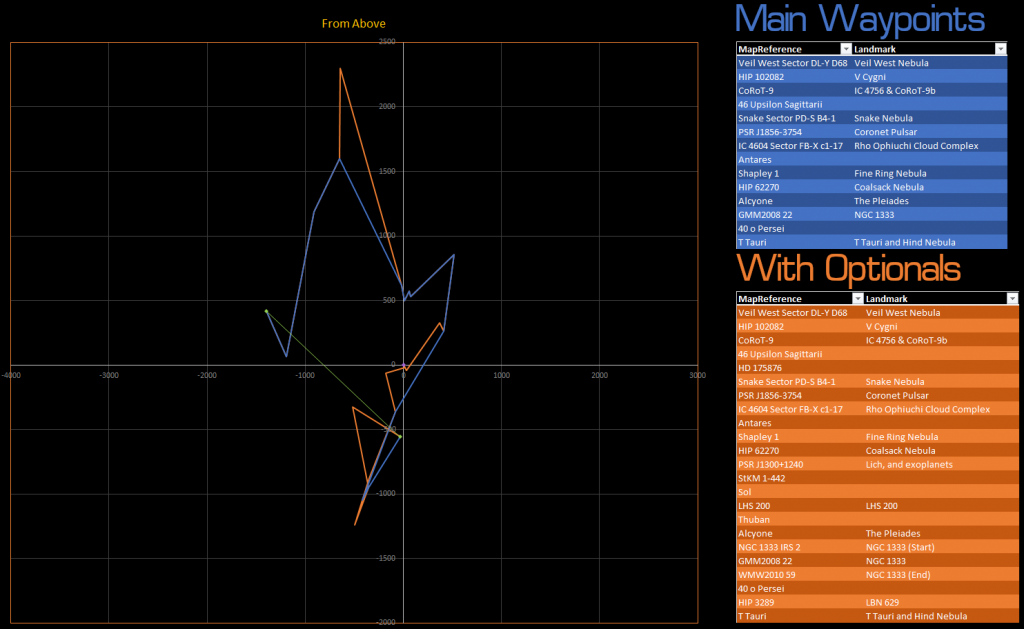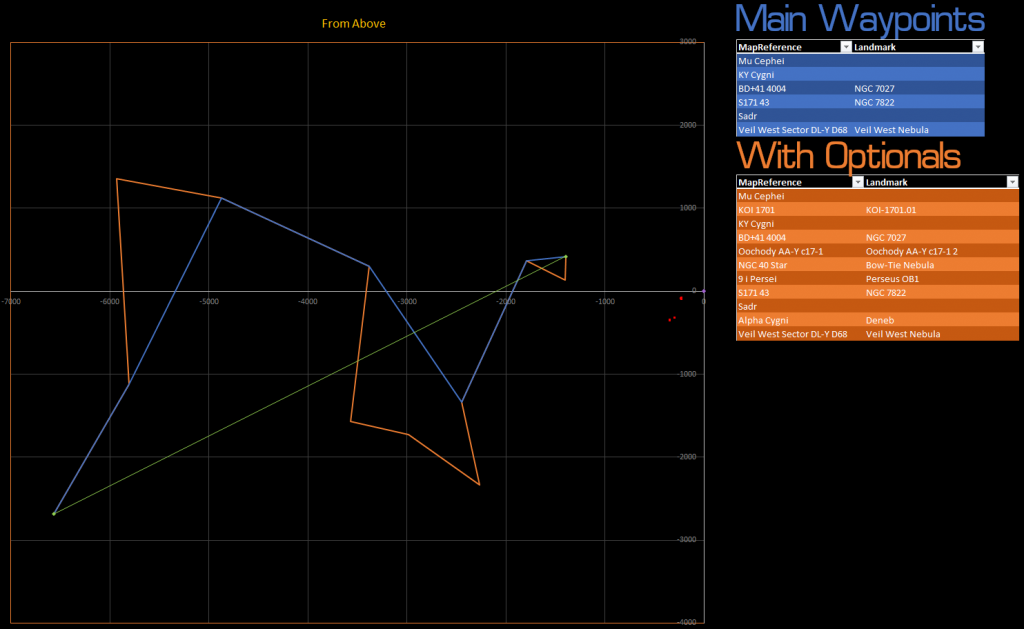We’ve now reached the fourth and final leg of Celebration of Early Astronomy 4 which will take us to sight near and in the “populated bubble” region of the game, and finally stopping off at our destination in T Tauri.
Dates
Start Date: February 19, 2022
End Date: March 05, 2022
Distances
Basecamp Line: 1,678.44 Ly
Main Waypoints: 7,798.27 Ly
Optional Waypoints: 10,882.09 Ly
Map, (click for full size):

Basecamp: T Tauri
Main Waypoints
- Map References quick reference list, more details below
- HIP 102082
- CoRoT-9
- 46 Upsilon Sagittarii
- Snake Sector PD-S B4-1
- PSR J1856-3754
- IC 4604 Sector FB-X C1-17
- Antares
- Shapley 1
- HIP 62270
- Alcyone
- GMM2008 22
- 40 o Persei
- T Tauri
Main Waypoints Details
- Map Reference: HIP 102082
- AKA: V Cygni
- A very large carbon star with only twice the mass of our sun, but nearly 200 times the size of our sun.
- Map Reference: CoRoT-9
- POI: CoRoT-9b
- This waypoint is for both a stellar cluster and a confirmed extrasolar planet. The stellar cluster IC 4756 is a bright stellar cluster in the Serpens constellation, bright enough to be seen with the naked eye. It is also known as Graff’s Cluster after astronomy Kasimir Graff. Additionally the system known as CoRoT-9 is located within this cluster and contains the confirmed extrasolar planet of CoRoT-9b (CoRoT-9 1 in-game). The CoRoT catalog is the result of a space telescope mission looking for extrasolar planets. Systems named in the CoRoT catalog will have confirmed extrasolar planets. — The SIMBAD Strabsourg link for CoRoT-9b is: https://simbad.u-strasbg.fr/simbad/sim-id?Ident=%405278222&Name=CoRoT-9b and the SIMBAD Strasbourg link for IC 4756 is: https://simbad.u-strasbg.fr/simbad/sim-id?Ident=IC+4756
- SIMBAD Link
- EDSM Link
- Map Reference: 46 Upsilon Sagittarii
- A blue supergiant visible from Earth by the naked eye. Also listed as a green system in case you need to restock on your FSD injection materials. Mammon Monitoring Facility is also near this location in the Mammon system.
Station near route from this waypoint to next: Mammon Monitoring Facility in Mammon - SIMBAD Link
- A blue supergiant visible from Earth by the naked eye. Also listed as a green system in case you need to restock on your FSD injection materials. Mammon Monitoring Facility is also near this location in the Mammon system.
- Map Reference: Snake Sector PD-S B4-1
- POI: Snake Nebula
- A thin wavy “snake shaped” dark nebula, also known as Barnard 72
- SIMBAD Link
- EDSM Link
- Map Reference: PSR J1856-3754
- POI: Coronet Pulsar
- The Coronet Pulsar, cataloged as RX J1856.5-3754 and PSRJ1856-3754 is the closest known neutron star to our own solar system. It was hypothesised for a time to be a “quark star” a still hypothetical star type called a quark star because of early measurements erroneously gauging it as having a surface temperature of 700,000 Celsius. Later measurements more accurately showed a surface temperature of 434,000 Celsius, allowing it to fit back within the models for neutron stars.
- SIMBAD Link
- EDSM Link
- Map Reference: IC 4604 Sector FB-X C1-17
- POI: Rho Ophiuchi Cloud Complex
- The Rho Ophiuchi cloud complex is a dark nebula of gas and dust that is located 1° south of the star ρ Ophiuchi of the constellation Ophiuchus. At an estimated distance of 131 ± 3 parsecs, it is one of the closest star-forming regions to the Solar System
- SIMBAD Link
- EDSM Link
- Map Reference: Antares
- The 15th brightest star in the night sky and the brightest star in the Scorpius constellation. It is often referred to as The Heart of the Scorpion because of its distinct red hue when viewed with the naked eye. It is a red supergiant and among the largest known stars. It also has a companion star Antares B which is a typical B-class star
- Map Reference: Shapley 1
- POI: Fine Ring Nebula
- Shapley 1 was discovered in 1936 by Harlow Shapley, it is an annular planetary nebula viewed from Earth almost perfectly perpindicular. In reality it is determined that the central star is a white dwarf, however in-game it is represented by a Wolf-Rayet. This may be due to new data since the in-game galaxy was created.
- SIMBAD Link
- EDSM Link
- Map Reference: HIP 62270
- POI: Coalsack Nebula
- The Coalsack Nebula is the most prominent dark nebula in the night sky from our solar system. It is easily visible to the naked eye as a fark patch obscuring a brief section of the Milky Way (as long as your skies are dark enough to see the Milky Way as a band.)
- SIMBAD Link
- EDSM Link
- Map Reference: Alcyone
- POI: The Pleiades
- The Pleiades is an open star cluster of more than 800 stars location in the Taurus constellation of the night sky. The most prominent stars of it are the stars Maia, Electra, Taygeta, Celaeno, Alcyone, Sterope, and Merope. Then there are the two parent stars named after Atlas and Pleione off to the side from the other seven.
The automotive company Subaru is named after the Japanese name for this cluster as well as borrowing their logo as a stylized representation of the cluster as well. - SIMBAD Link
- Map Reference: GMM2008 22
- POI: NGC 1333
- NGC 1333 is a reflection nebula located in the Perseus constellation and part of the Perseus Molecular Cloud
- SIMBAD Link
- EDSM Link
- Map Reference: 40 o Persei
- 40 Persei is a binary star system in the Perseus constellation. Bayer designation is o Persei, and Flamsteed designation is 40 Persei; “40 o Persei” is just Elite mashing up those two names for some reason. 40 Persues is a member of the Perseus OB2 association, which is a cluster of stars moving together, which also contains HD 21856, 38 Persei, HD 24131, X Persei, 44 Persei, and 46 Persei.
- Map Reference: T Tauri
- POI: T Tauri & Hind Nebula
- T Tauri is a variable star in the Taurus constellation, and the prototypical star of the T Tauri class of variable stars. It was discovered in October 1852 by John Russel Hind, after which it’s planetary nebula, the Hind Variable Nebula was also named. — Strangely enough despite being the prototype star of the T Tauri classe of stars, the in-game representation does not have them as T Tauri stars.
- SIMBAD Link
- EDSM Link
Optional Waypoints
- Map References quick reference list, more details below
- HIP 102082
- CoRoT-9
- 46 Upsilon Sagittarii
- HD 175876
- Snake Sector PD-S B4-1
- PSR J1856-3754
- IC 4604 Sector FB-X c1-17
- Antares
- Shapley 1
- HIP 62270
- PSR J1300+1240
- StKM 1-442
- Sol
- LHS 200
- Thuban
- Alcyone
- NGC 1333 IRS 2
- GMM2008 22
- WMW2010 59
- 40 o Persei
- HIP 3289
- T Tauri
Optional Waypoints Details
Map Reference: HD 175876
AKA: Heaven’s Lathe
The bright O-type star HD 175876 has a companion neutron-star with a surprising feature: Extremely large rings. The effective radius of the rings are 12 light seconds, and it has a mass of 5.16 x 10^17 kg – slightly greater than Thebe, a small moon of Jupiter. As the neutron star has a radius on the order of 10km, this object has an exceptionally large ring size relative to the central body. These massive metal-rich rings would provide enough material for hundreds of years for any colony.
Map Reference: PSR J1300+1240
POI: Lich, and exoplanets
Where the first extrasolar planets were discovered in 1992. It is a millisecond pulsar with a rotation period of a mere 6.22 milliseconds (9,650 rpm), but was found to have slight anomalies in its rotational period, leading to investigations as to the cause of that. Those investigation led to the confirmation of the first planets found outside of our own solar system. In 1994 an additional planet was also found in orbit of this pulsar.
Too far to be reachable by most ships, is an optional waypoint as a result
Route to: This route was found by CMDR Merlinsan during this expedition and has been edited into this post, start at HD 112186.

To get back out, can Neutron Boost back to Ushott ZP-X D1-0 and then two jumps to CG-X where 60+ Ly ships should be able to proceed normally from.
Map Reference: StKM 1-442
StKM 1-442 is a binary star in the Stephenson K & M stellar catalog which focuses on K and M class main sequence stars. However in-game it is not accuratley displayed as a binary system.
If you have exploration data to sell, this is a system belonging to our own Player Minor Faction, C.E.A. Psychiatric Institutions Ltd. and selling exploration data here could help boost our influence here so that we can expand to further systems.
Map Reference: Sol
First discovered in 450 BC by Anaxagoras, Sol is a G-class main sequence star of exactly 1 solar mass and 1 solar radii. It also hosts a mostly harmless Earth-like world “Earth” as its third planets, containing sentient lifeforms known as humans. (although their sentience is sometimes questionable)
What we mean by discovered in 450 BC by Anaxagoras is that this they were first to propose that our Sun may be a star like the other ones in the sky. It was later again suggested by Aristarchus of Samos, but did not catch on until later on still.
Other important first discoveries in this system:
Mercury, Venus, Mars, Jupiter, and Saturn: 2nd millenium BC by Babylonian astronomers. Used as evidence of the helicentric model by Aristarchus of Samos, and later in De Revolutionibus Orbium Coelestium by Nicolaus Copernicus
Ganymede, Callisto, Io, Europa: 7th and 8th January 1610 by Galileo Galilei
Titan: Christiaan Huygens, 13 June 1655
Iapetus and Rhea: Giovanni Domenico Cassini, 25 October 1671 & 23 December 1672 respectively
Tethys & Dione: Giovanni Domenico Cassini, 21 March 1684, published in Kosmotheôros
Uranus: William Herschel: March 13, 1781
Titania & Oberon: William Herschel, January 11, 1787
Enceladus & Mimas: William Herschel, August 28, 1789 & September 17, 1789 respectively
Neptune: Johann Gottfried Galle & Urbain Le Verrier on September 23, 1846
Deimos & Phobos: Asaph Hall, August 12th & 18th 1877 respectively
Pluto: Clyde Tombaugh, February 18, 1930
First to reach space and return alive: A pair of fruit flies (Drosophila melanogaster), February 20, 1947.
First orbital spaceflight: Laika (species: Canis familiaris), November 3, 1957
First human in space: Yuri Gagarin, April 12, 1961
First footfall on Moon: Neil Armstrong, July 20, 1969. Followed by Edwin Buzz Aldrin immediately after.
Map Reference: LHS 200
K class main sequence star. For Odyssey players there is a good view from LHS 200 1 A on a ringed planet orbiting another ringed planet.
Map Reference: Thuban
Thuban, also known as Alpha Draconis is a binary star system in the Draco constellation. Thuban was Earth’s north star between 4th and 2nd millenium BC instead of Polaris.
Map Reference: NGC 1333 IRS 2
POI: NGC 1333 (Start point)
This system marks the start of the NGC 1333 cluster as a waypoint.
NGC 1333 is a reflection nebula located in the Perseus constellation and part of the Perseus Molecular Cloud
Map Reference: WMW2010 59
POI: NGC 1333 (End point)
This system marks the end of the NGC 1333 cluster as a waypoint.
NGC 1333 is a reflection nebula located in the Perseus constellation and part of the Perseus Molecular Cloud
Map Reference: HIP 3289
POI: LBN 629
LBN 623 Nebula, also known as IC63, is a dark purple emission nebula. It has also been called the Gamma Cassiopeiae nebula due to visual proximity of that bright star and the nebula as seen from old Earth.

